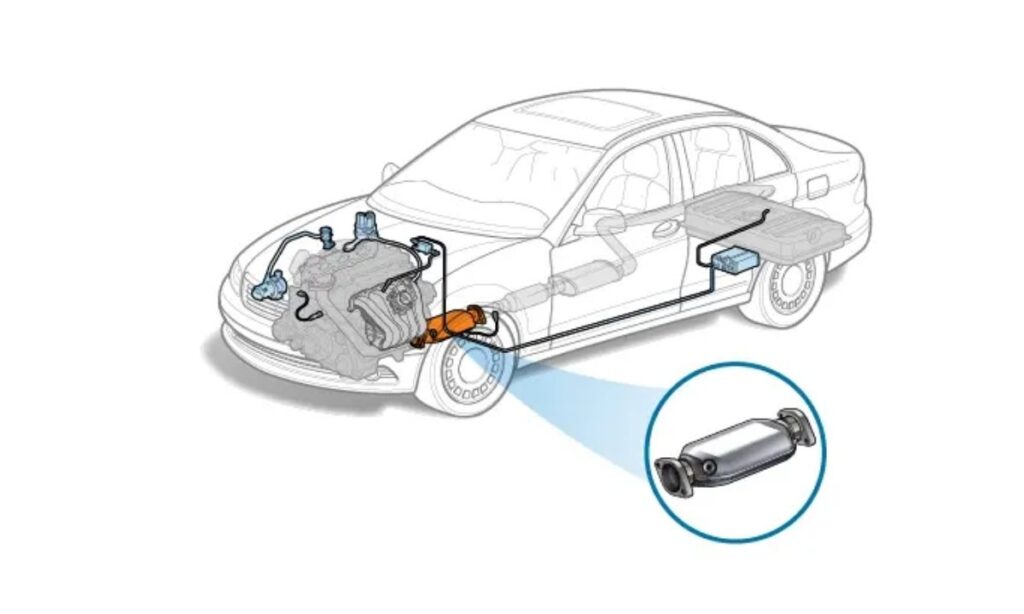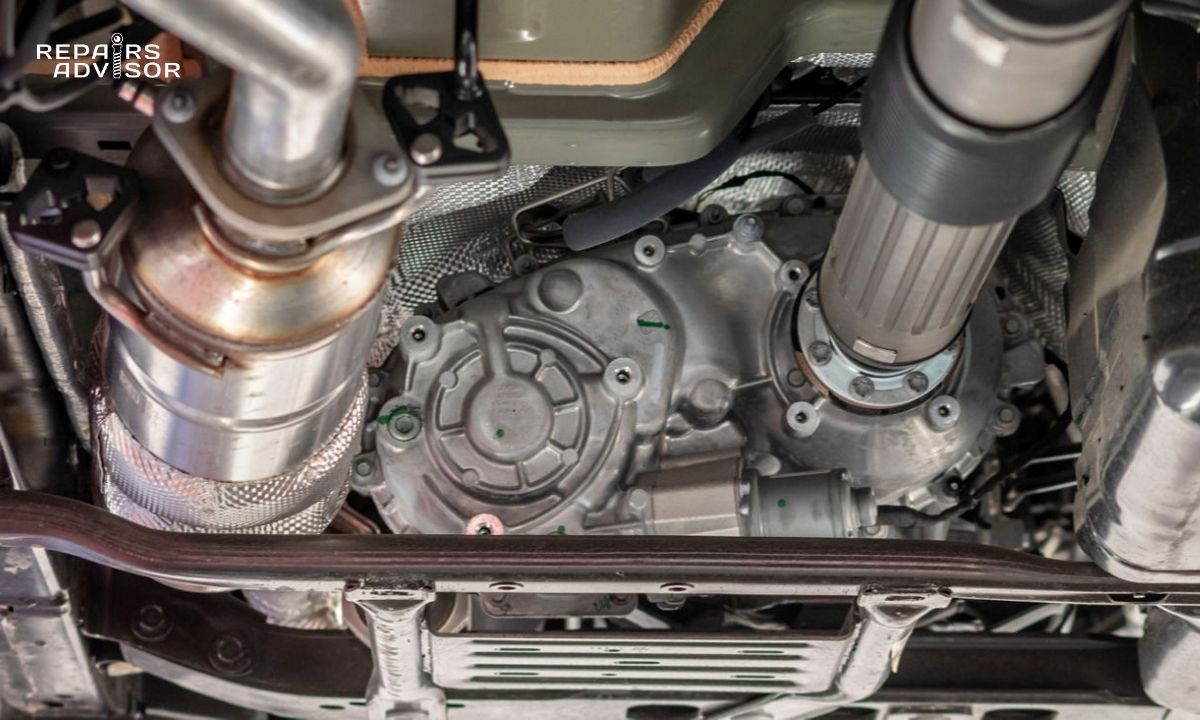The catalytic converter, often affectionately called a “cat,” is an absolutely essential component of your vehicle’s exhaust system, whether it runs on gasoline or diesel. Its vital role is to act as an emissions control device, transforming harmful pollutants from your engine’s exhaust into less toxic gases before they exit the tailpipe.
Typically shaped like a metal canister and installed in the exhaust system near the engine, the catalytic converter contains a honeycomb-like structure coated with precious metals such as platinum, palladium, and rhodium. As raw exhaust gases flow through this structure, a series of complex chemical reactions occur. The ultimate goal is to convert dangerous compounds like nitrogen oxides (NOx), carbon monoxide (CO), and unburnt hydrocarbons (HC) into relatively harmless substances like nitrogen (N2), carbon dioxide (CO2), and water vapor (H2O).
A faulty catalytic converter is not only an environmental concern but also a critical vehicle problem that needs immediate attention. Your car will not pass emissions testing with a bad converter, and serious engine issues can arise.

Symptoms of a Bad or Failing Catalytic Converter
Recognizing the signs of a failing catalytic converter is crucial for both your car’s health and the environment:
- Illuminated Check Engine Light (CEL):
- This is the most common and often the first indicator. Your car’s computer (ECM) monitors the catalytic converter’s efficiency using oxygen sensors positioned in the exhaust system. There’s an “upstream” oxygen sensor located before the converter and a “downstream” oxygen sensor placed after it.
- The catalytic converter’s job is to filter out harmful gases, so the readings from these two sensors should be significantly different. If the ECM detects that the readings from the upstream and downstream sensors are too similar, it indicates the converter isn’t doing its job effectively. In this situation, the Check Engine Light will illuminate, and the ECM will store a specific diagnostic trouble code (DTC), most commonly a P0420 (Catalyst System Efficiency Below Threshold – Bank 1) or P0430 (for Bank 2 on V-engines).
- Failed Vehicle Emissions Test:
- In areas requiring emissions testing, a bad catalytic converter will almost certainly lead to a failed vehicle emissions test. If your car has a faulty catalytic converter, the associated trouble code (like P0420) will be stored in the engine’s computer. During the diagnostic check that’s part of the emissions test, this stored code will prevent your vehicle from passing. Even if no CEL is currently on, a “pending” code or a lack of “readiness monitors” (due to a previous code being cleared) will cause a failure.
- Unusual Exhaust Smell (Rotten Eggs/Sulfur):
- Gasoline contains sulfur. During engine combustion, this sulfur can be converted into hydrogen sulfide, which has a distinct, unpleasant odor. A healthy catalytic converter changes this hydrogen sulfide into sulfur dioxide, which is odorless.
- If your catalytic converter is inefficient or failing, it won’t perform this conversion effectively, allowing more unburnt fuel (and the hydrogen sulfide byproduct) to escape. This will result in a strong, sulfur-like or “rotten egg” smell coming from your exhaust.
- Significant Lack of Engine Power / Poor Acceleration:
- In some cases, the internal honeycomb structure of a catalytic converter can melt or become severely plugged up. This often happens when unburnt fuel ignites inside the catalyst material due to engine issues like misfires, causing it to overheat and deteriorate.
- A plugged catalytic converter creates a severe exhaust restriction, preventing exhaust gases from escaping the engine efficiently. This significantly impacts the engine’s ability to “breathe,” leading to a noticeable loss of power, sluggish acceleration, and the need for significantly more throttle input to maintain speed or accelerate. Eventually, if the converter becomes completely blocked, the engine may barely run or not run at all.
- Rattling Noise Under the Vehicle:
- The ceramic or metallic honeycomb catalyst material inside the converter’s metal casing can break apart due to age, impact, or extreme heat (from misfires). If this material fractures, the loose pieces will rattle around inside the converter’s casing when the engine is running, especially at idle or during acceleration. This sounds like loose rocks or marbles in a tin can. If not addressed, these broken parts can travel further down the exhaust stream and get stuck in the muffler or resonator, creating an even more severe restriction and potentially damaging those components as well.

How to Fix a Bad Catalytic Converter
Diagnosing a failed catalytic converter requires professional expertise, as the symptoms can sometimes overlap with other engine or exhaust issues.
- Professional Diagnosis is Essential:
- A qualified technician will begin with a comprehensive diagnostic process.
- Physical Inspection: They’ll physically inspect the catalytic converter for any obvious signs of damage, such as dents, cracks, or severe discoloration (indicating overheating). They’ll also listen for the distinctive rattling noise.
- Exhaust Backpressure Test: For situations involving a lack of engine power, a crucial test is an exhaust system backpressure test. This measures the pressure within the exhaust system before the catalytic converter. High backpressure readings confirm a plugged converter, indicating it’s restricting exhaust flow.
- Scan Tool Data Analysis: The technician will use a professional scan tool to analyze live data from the oxygen sensors (upstream and downstream) to confirm if the converter is truly inefficient (P0420/P0430 codes). They may also check fuel trims and misfire counters.
- Address the Root Cause of Failure:
- Crucially, almost all catalytic converter failures are due to an underlying issue with the engine, not just a standalone fault of the converter itself. An engine that isn’t running optimally can “poison” or melt a catalytic converter by dumping too much raw, unburnt fuel into the exhaust, or by burning oil or coolant.
- Identifying the Culprit: Before installing a new catalytic converter, it is imperative that the underlying cause of the failure is accurately determined and repaired. Common engine issues that can destroy a catalytic converter include:
- Faulty fuel injectors: Leaking or clogged injectors can cause an improper air/fuel mixture.
- Bad ignition coils or fouled spark plugs: These lead to engine misfires, sending raw fuel into the exhaust. A flashing Check Engine Light indicates a severe misfire that can damage a catalytic converter very quickly. In this situation, the engine should be shut off immediately, and the car should be towed to a repair shop for diagnosis, as continuing to drive can cause irreversible damage in minutes.
- Leaking fuel pressure regulator: Can lead to an excessively rich fuel mixture.
- Excessive oil consumption: Burning oil can clog the catalyst material.
- Coolant leaks: Coolant entering the exhaust can also damage the catalyst.
- Protecting Your Investment: Failure to diagnose and repair the root cause before installing a new catalytic converter will almost certainly ruin the new converter as well, and its warranty typically will not cover damage caused by underlying engine problems.
- Replacement of the Catalytic Converter:
- Once the root cause is fixed and the catalytic converter is confirmed faulty, the old converter will be removed and replaced with a new, emissions-compliant unit. This often involves cutting and welding or unbolting from flanges, depending on the vehicle.
Beware of Catalytic Converter Theft!
It’s important to be aware that catalytic converters are a frequent target for thieves. They are often stolen because they contain valuable precious metals like platinum, palladium, and rhodium, which can be sold for scrap. A skilled thief can remove a catalytic converter in a matter of minutes.
Signs of a missing catalytic converter include an extremely loud exhaust sound (it will sound like an open pipe or a truck, even in a small car). If you suspect theft, call the police immediately. Some insurance policies will cover the replacement cost of a stolen catalytic converter, so check your coverage.
Conclusion
A faulty catalytic converter is a critical problem for your vehicle’s performance, emissions compliance, and overall health. Ignoring its symptoms can lead to failed inspections, severe engine power loss, and even costly damage to other exhaust components. Moreover, the failure of a catalytic converter often signals a deeper issue within your engine that must be addressed.
Don’t delay getting your catalytic converter issue diagnosed. Driving with a bad “cat” isn’t just bad for the environment; it’s bad for your car and can quickly turn a manageable repair into a much larger, more expensive one.
For an accurate diagnosis and a lasting solution, always consult a qualified automotive technician. They have the specialized tools and expertise to pinpoint the true cause of your catalytic converter’s failure and ensure that both the converter and any underlying engine problems are properly repaired. Protect your investment and the air we breathe – schedule a professional inspection today!
